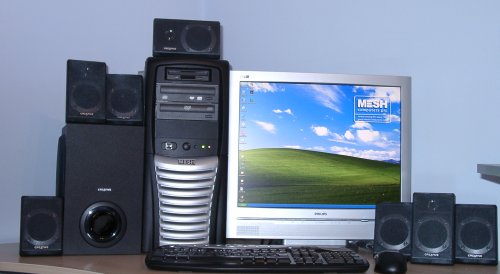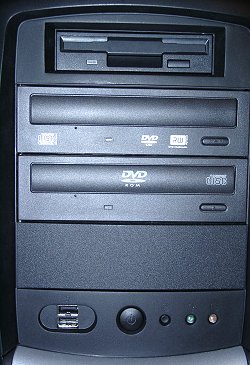External appearance
| System name | MESH Titan X1800 Fire System |
| Processor | AMD Athlon 64 X2 4600+ (dual-core CPU. 2.4GHz, 512KB L2 cache per core) |
| Motherboard | ASUS A8R-MVP Radeon Xpress 200 CrossFire |
| Memory | 1GByte (2x 512MByte) Samsung Original @ 3-3-3-8 2T DDR400 |
| Hard Drives | 300GB Maxtor 6L300S0 16MB Cache SATA |
| Screen | Philips 200S4SS 20.1-inch TFT. 1600x1200 native resolution, DVI/VGA inputs |
| Graphics card | ATI X1800 XT CrossFire (2x Radeon X1800 XTs) |
| Optical drive 1 | Sony 16X Dual-layer DVD +/- RW DW-Q28A | Optical drive 2 | Sony 16X DVD-ROM DDU-1615A |
| Audio | Creative Labs X-Fi XtremeMusic | Speakers | Creative Inspire 7900 (7.1-channel) |
| Modem | None |
| Networking | Marvell 88E8001 PCIe Gigabit Ethernet | Ports connectivity | 6x USB2.0, 1x FireWire400, GbE, PS/2, Parallel, Serial, audio, S/PDIF-out (RCA) |
| Operating system | Windows XP Home SP2 |
| Warranty | MESH 3-year (2-year onsite + 1-year BTB |
| Price | £1999.99 including VAT (£1701.28 ex. VAT) (as at 13th January 2006) |
| Shipping | £45.83 including VAT |
| Other notables | CrossFire system |

A look at the £2000 MESH Titan X1800 Fire system in all its glory. The vast majority of the money is in the silver-fronted box in the middle that houses the first retail ATI CrossFire system we've come across. Completing the package is a Philips 200S4SS 20.1-inch TFT. Creative provides the speakers, in this case its Inspire 7900 that provide decent sound quality and 7.1 (8-speaker output) when allied to the Creative X-Fi ExtremeMusic soundcard's outputs. The speakers didn't feature digital inputs but the soundcard's excellent signal-to-noise ratio (SNR) effectively masked that shortcoming. Logitech's cordless keyboard and optical mouse are standard fare, although both miss the features found on models higher up; laser optics and dedicated gaming keys spring to mind.
It's strange to see MESH ship a silver TFT with a system that's predominantly black (albeit with a silver front), surely a slimline black model would have kept up MESH's cool aesthetic. The Philips 2004SS provides a clear, crisp picture and has both DVI and VGA inputs. Right now, the two ATI Radeon X1800 XT cards, configured in CrossFire mode for superlative performance, need to be taxed by ultra-high resolutions and high I.Q. 1600x1200, the panel's maximum resolution may not be enough to get the most out of them. Something like a 24-inch wide-aspect WUXGA screen (1920x1200) would do the trick, at extra expense, obviously.

MESH uses the upper expansion bay to house the archaic floppy drive. Subjectively, we'd be happy for it to be replaced by a USB-powered multicard reader that would provide the user with more value. Overall chassis build quality is good, with no rattling or ill-fitting components. Sony provides both the optical drives in the form of its 16x DDU-1615A DVD-ROM drive and 16x DW-Q28A multiformat dual-layer DVD ReWriter that both match the exterior's black finish. There's a spare 5.25" expansion bay underneath, again perfect for housing a multicard reader (hint, hint). In minimalist fashion, the front only contains power and reset buttons.

Combined with the front, the rear provides 6 USB2.0 ports, only a single FireWire400 port, an RJ45 socket for the board's Gigabit Ethernet, and a range of legacy ports. The real fun, and where the system's name is derived from, is at the bottom. MESH ships the Titan X1800 Fire with a couple of ATI Radeon X1800 XT 512MB cards that are currently the highest-performing SKU from the Canadian outfit. The loopback cable connects both together and some nifty behind-the-scenes technology, known to the world as CrossFire, works in a broadly similar fashion to NVIDIA's SLI tech. to produce multi-GPU performance that gamers crave. A single Radeon X1800 XT 512MB is no 3D slouch. 2 cards in CrossFire formation will provide enough rendering oomph to make the most of the supplied panel's 1600x1200 resolution, and then some.
Before you consider building one yourself, CrossFire requires a compatible motherboard and a Master Card (the one closest the bottom of the chassis, strangely) and a regular PCI-Express-based Radeon card to work, preferably from the same family. The Master Card carries a compositing engine, and the loopback cable, run via DVI and terminating on a special connector on the Master, transmits the data needed for the multi-GPU CrossFire technology to work correctly.









